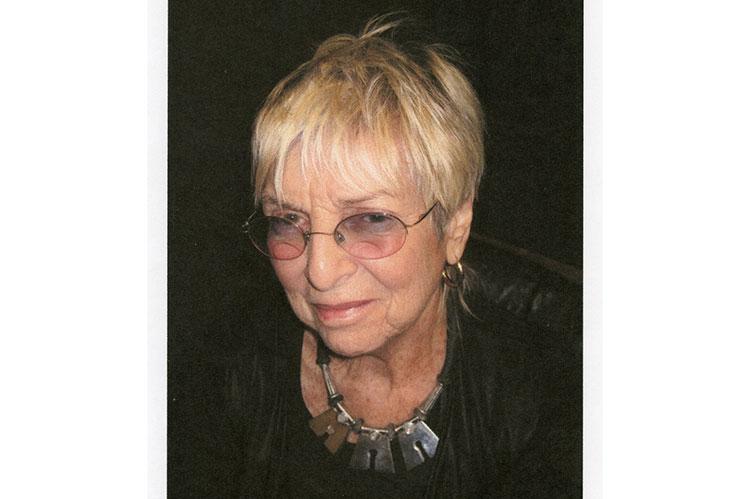For more than 70 years, Audrey Flack followed her own path in art and life. Writing in The Star about “Queen of Hearts,” a 2019 documentary about Ms. Flack, Jennifer Landes noted that in the production notes the filmmakers called her “an octogenarian and a trailblazer. What is clear from the film and can be corroborated by anyone who knows her is that she is much more of the latter than the former.”
Ms. Flack, who divided her time between East Hampton and New York City, died at Stony Brook Southampton Hospital on June 28. She was 93. Her death was caused by an aortic tear, according to her daughter Hannah Marcus.
Her career began in the early 1950s, the heyday of Abstract Expressionism. “Back in the ’50s she was a very accomplished Abstract Expressionist, better than most of the women then who were almost all overshadowed by the men,” Louis K. Meisel, an art dealer, said in an email. “I represented her for 40 years, and have continued working for and with her till the end. We were great friends.”
During that decade she was immersed in the downtown New York art scene, hanging out at the Cedar Tavern and socializing with such titans as Jackson Pollock, Willem de Kooning, and Franz Kline, but, according to her memoir, “With Darkness Came Stars,” she didn’t sleep with any of them. “I wasn’t attracted to testosterone-fueled aggression and out-of-control drinking,” she wrote.
Her career took off during the 1970s, when she developed her own Photorealist vocabulary. While that movement, whose name was coined by Mr. Meisel, is often associated with automobiles, storefronts, and other shiny surfaces, Ms. Flack painted elaborate still lifes of jewelry, lipsticks, mirrors, skulls, tarot cards, pastries, even a photograph of Marilyn Monroe. In 1975, hers was the first Photorealist painting to enter the collection of the Museum of Modern Art.
Ms. Flack shifted to sculpture in the 1980s, “creating goddesses and women from mythology as capable and powerful subjects rather than mere objects to behold,” according to the Smithsonian American Art Museum. “With public commissions, Flack focused on strong and intelligent women in direct counterpoint to the prevalence of ‘generals on horses’ historically celebrated in monuments.”
She returned to large-scale painting in the 2010s with her “Post Pop Baroque” series, which combined elements of Renaissance and Baroque art history with contemporary elements.
Of that series, which pairs superheroes with Rubenesque figures, Ms. Landes said it was “the latest manifestation of her engagement with realism, art history, and comic-book illustration, which have occupied much of her career in one form or another. Now they have been synthesized into something new, a pastiche that transcends its sources.”
Ms. Flack was born in Manhattan on May 30, 1931, to Morris Flack and the former Jeanette Flichtenfeld. After graduating from the High School of Music and Art, she attended Cooper Union, then transferred to Yale, where she earned a B.F.A. in 1952 and studied with Josef Albers.
Her first marriage, to Frank Levy, a cellist, ended in divorce. Their first child, Melissa, was eventually diagnosed with severe autism, but only after being misunderstood by her husband and several doctors. According to Regina Weinreich’s review of “With Darkness Came Stars” in The Star last week, “Ms. Flack’s writing about her daughter is sensitive and heartbreaking.”
She married Bob Marcus, an old boyfriend, in 1970, and he adopted her daughters. In addition to Melissa and Hannah, she is survived by a stepdaughter, Leslie Marcus, a stepson, Mitchell Marcus, four grandchildren, and two great-grandchildren. Mr. Marcus died in May. Another stepdaughter, Aileen Marcus, died in 2022.
Hollis Taggart, who also represents Ms. Flack’s work, said in a statement, “We mourn the loss of a true artistic legend who left an indelible mark on the history of American art. Audrey’s boundless creativity defined her career, which spanned seven decades. . . . Her acclaimed memoir, published only months before her passing, reveals her true spirit and her ability to overcome all obstacles and achieve her ambitious goals.”
Ms. Flack’s studio manager, Chloe Pitkoff, told The Art Newspaper in a statement, “There are very few people I have been able to speak so deeply about art with and explore alongside so collaboratively — and I witnessed so many other people she made feel this way, from her students to fellow artists and other members of the creative community. I was fortunate to have experienced so many of these conversations over the time we learned and worked together.”
A memorial service read-in will be held at The Church in Sag Harbor on July 20 at 3 p.m. Those interested in reading a passage from Ms. Flack’s memoir can email [email protected] for more details.
“Audrey Flack: Mid-Century to Post-Pop Baroque,” a career-spanning exhibition, will open at the Parrish Art Museum in Water Mill on Oct. 13.




